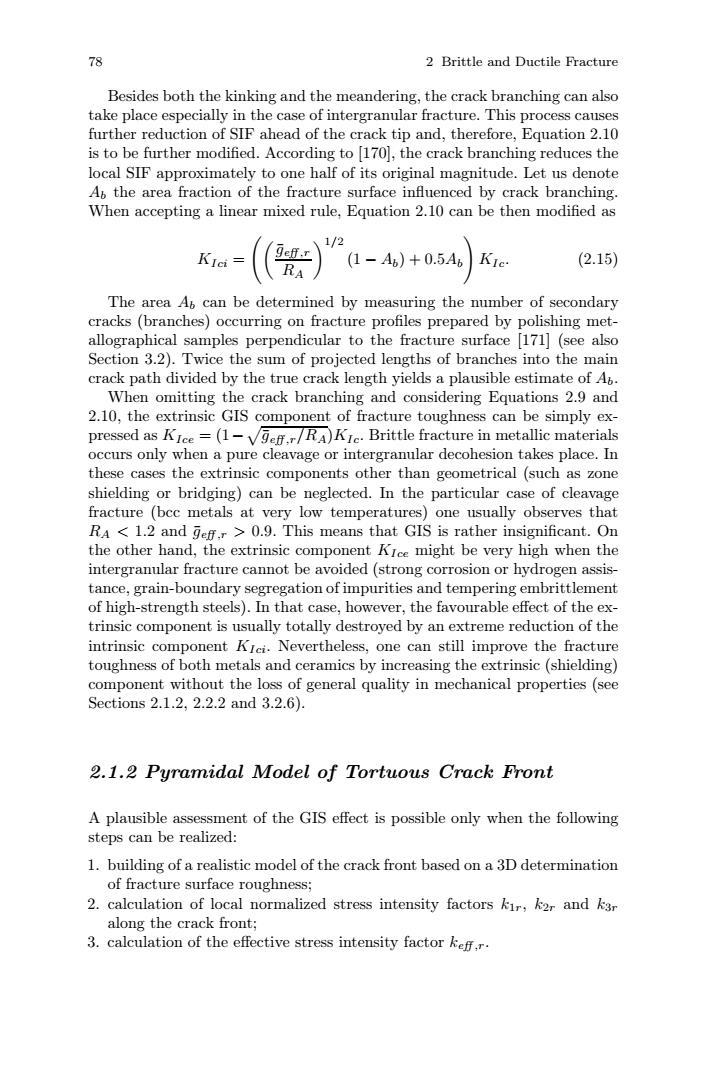正在加载图片...

78 2 Brittle and Ductile Fracture Besides both the kinking and the meandering,the crack branching can also take place especially in the case of intergranular fracture.This process causes further reduction of SIF ahead of the crack tip and,therefore,Equation 2.10 is to be further modified.According to [170],the crack branching reduces the local SIF approximately to one half of its original magnitude.Let us denote A the area fraction of the fracture surface influenced by crack branching. When accepting a linear mixed rule,Equation 2.10 can be then modified as 1/2 KIci geff.r (1-A6)+0.546 (2.15) RA The area A can be determined by measuring the number of secondary cracks(branches)occurring on fracture profiles prepared by polishing met- allographical samples perpendicular to the fracture surface [171](see also Section 3.2).Twice the sum of projected lengths of branches into the main crack path divided by the true crack length yields a plausible estimate of Ab. When omitting the crack branching and considering Equations 2.9 and 2.10,the extrinsic GIS component of fracture toughness can be simply ex- pressed as KIce=(1-./RA)KIe.Brittle fracture in metallic materials occurs only when a pure cleavage or intergranular decohesion takes place.In these cases the extrinsic components other than geometrical (such as zone shielding or bridging)can be neglected.In the particular case of cleavage fracture (bcc metals at very low temperatures)one usually observes that RA 1.2 and gef.r>0.9.This means that GIS is rather insignificant.On the other hand,the extrinsic component Kice might be very high when the intergranular fracture cannot be avoided(strong corrosion or hydrogen assis- tance,grain-boundary segregation of impurities and tempering embrittlement of high-strength steels).In that case,however,the favourable effect of the ex- trinsic component is usually totally destroyed by an extreme reduction of the intrinsic component KIci.Nevertheless,one can still improve the fracture toughness of both metals and ceramics by increasing the extrinsic(shielding) component without the loss of general quality in mechanical properties(see Sections2.1.2,2.2.2and3.2.6). 2.1.2 Pyramidal Model of Tortuous Crack Front A plausible assessment of the GIS effect is possible only when the following steps can be realized: 1.building of a realistic model of the crack front based on a 3D determination of fracture surface roughness; 2.calculation of local normalized stress intensity factors kir,k2r and k3r along the crack front; 3.calculation of the effective stress intensity factor Keff.r.78 2 Brittle and Ductile Fracture Besides both the kinking and the meandering, the crack branching can also take place especially in the case of intergranular fracture. This process causes further reduction of SIF ahead of the crack tip and, therefore, Equation 2.10 is to be further modified. According to [170], the crack branching reduces the local SIF approximately to one half of its original magnitude. Let us denote Ab the area fraction of the fracture surface influenced by crack branching. When accepting a linear mixed rule, Equation 2.10 can be then modified as KIci = g¯eff ,r RA 1/2 (1 − Ab)+0.5Ab KIc. (2.15) The area Ab can be determined by measuring the number of secondary cracks (branches) occurring on fracture profiles prepared by polishing metallographical samples perpendicular to the fracture surface [171] (see also Section 3.2). Twice the sum of projected lengths of branches into the main crack path divided by the true crack length yields a plausible estimate of Ab. When omitting the crack branching and considering Equations 2.9 and 2.10, the extrinsic GIS component of fracture toughness can be simply expressed as KIce = (1−g¯eff ,r/RA)KIc. Brittle fracture in metallic materials occurs only when a pure cleavage or intergranular decohesion takes place. In these cases the extrinsic components other than geometrical (such as zone shielding or bridging) can be neglected. In the particular case of cleavage fracture (bcc metals at very low temperatures) one usually observes that RA < 1.2 and ¯geff ,r > 0.9. This means that GIS is rather insignificant. On the other hand, the extrinsic component KIce might be very high when the intergranular fracture cannot be avoided (strong corrosion or hydrogen assistance, grain-boundary segregation of impurities and tempering embrittlement of high-strength steels). In that case, however, the favourable effect of the extrinsic component is usually totally destroyed by an extreme reduction of the intrinsic component KIci. Nevertheless, one can still improve the fracture toughness of both metals and ceramics by increasing the extrinsic (shielding) component without the loss of general quality in mechanical properties (see Sections 2.1.2, 2.2.2 and 3.2.6). 2.1.2 Pyramidal Model of Tortuous Crack Front A plausible assessment of the GIS effect is possible only when the following steps can be realized: 1. building of a realistic model of the crack front based on a 3D determination of fracture surface roughness; 2. calculation of local normalized stress intensity factors k1r, k2r and k3r along the crack front; 3. calculation of the effective stress intensity factor keff ,r